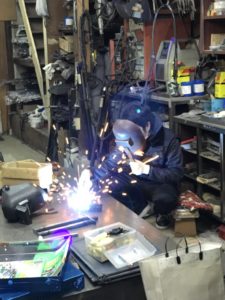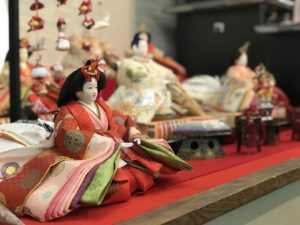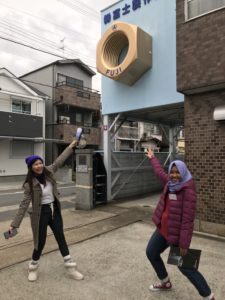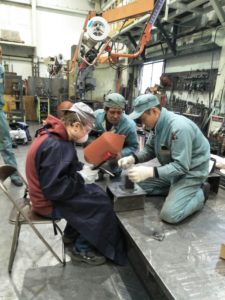With over 6,000 factories located in Higashi Osaka, this city contributes to the highly competitive edge of Japan’s manufacturing. On the 3rd of February, the MEXT scholars had the honor and privilege to visit 6 different factories. They were guided by highly skilled specialists in their various fields.
Kyokushin Gas Equipment Plant, Ltd.
The first stop was a Kyokushin Gas Equipment Plant, Ltd. They make custom-made specialty takoyaki pans, ikayaki, taiyaki and castella pans and supply it to the many different restaurants and food stands. The guide explained the different use of materials such as copper (apparently, it can last for decades!), tephlon, aluminum, etc in pan making. The scholars participated in some of welding activities and were even allowed to engrave their initials, using a hammer on a personal copper name plate!

Matsuyoshi-Doll Co
Second place on the agenda was the Matsuyoshi-Doll Co. In this factory, 15 specialists build 4,000 hand-made Japanese dolls a year. They manufacture dolls ranging from Hina dolls, used during Hinamatsuri, to modern dolls. Every part of the doll, from the hands, face, body, and clothing are produced by a different specialist. The scholars were allowed observe the work space and even participated in a workshop in which they made their own magnets using the kimono fabric used for the dolls. They were also taught about the many seasonal festivals that exist in Japan.

Nihon Kasen Co, Ltd
Third place on the agenda was Nihon Kasen Co, Ltd. This is a wire factory that manufactures the wire used in different areas such as construction, electric facilities, etc. They supply wires, all the way from Hokkaido to Okinawa. In addition, they also manufacture original craft color wire and hold a 95% share of Japanese hobby wire craft market with their brand: Jiyu-Jizai. They not only supply the industrial market but also the artisan markets. The scholars were allowed to make their own pen holder with the craft wire. At this point, the scholars were overwhelmed by the kind presents by the factories.
Fuji Sesakusho Co., Ltd.
Fourth place on the agenda was Fuji Sesakusho Co., Ltd. This factory manufactures thousands of different kinds of nuts and bolts. The scholars found this place to be the epitome of what a clean, organized, and efficient workplace could look like. This company is the promoter of the 5S system: sort, straighten, shine, standardize, and sustain. With the support of the Japanese government, they support the preservation of highly skilled workers and in turn this company continues to produce high precision and high quality products.

Sunrise Iron Co. Ltd.
Fifth place on the agenda was Sunrise Iron Co. Ltd. They produce the rod that controls the handle steering of almost all cars in Japan (Toyota, Nissan, Mitsubishi, etc.).This company went all out with their hospitality as they demonstrated their highly respected and rare flash-butt welding. They let all the scholars weld their own stainless steel pen stand and even gave them delicious udon . It was clearly visible that everyone were highly skilled and passionate about their work.

Nakatsuji Kanagata Kougyou Co. Ltd.
The last stop of the day was Nakatsuji Kanagata Kougyou Co. Ltd., which is a design company that produces different specialized components for cars and consumer electronics using molds that are crerated by them. This company currently produces the panel parts that will go into making the new train line being built in Kyushu next year. They also tap into the artisan market. They are now developing one of a kind coasters to appeal to more household consumers. The scholars got to make their own tin badges to take home.
While there were many spots on the tour, the MEXT scholars were very excited and inspired by the pride felt from the many Higashi Osaka craftspeople they visited. Many of them found renewed appreciation for the products they buy in Japan because they witnessed firsthand the labor and hard work that goes into making these things. It’s nice to know that not everything is being outsourced and produced by robots. Hopefully these companies will continue to succeed and keep educating enthusiastic visitors about their craftsmanship.
A big thanks to the organizers of the tour, the translator, and the many hands that went into making this tour a success!
Written by Chika Kondo. Photo credit: Fatemi Nawrose

